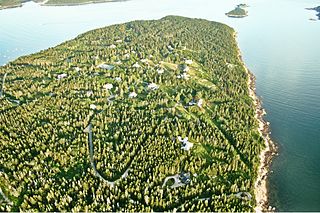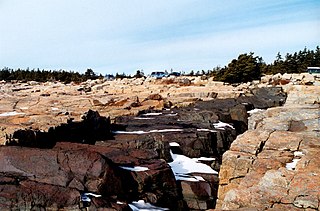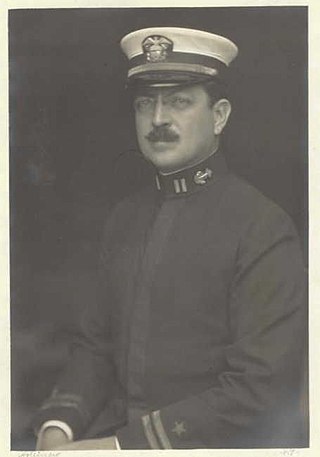
Winter Harbor is a town on the Schoodic Peninsula in Hancock County, Maine, United States. The population was 461 at the 2020 census. The town is located just outside the Schoodic Peninsula portion of Acadia National Park, and is due east of the town of Bar Harbor and Ellsworth. Winter Harbor was once the location of a US Naval Station, NSGA-WH, which closed in the mid-2000s, and is now home to the Schoodic Institute’s Education and Research Center.

Mount Desert Island in Hancock County, Maine, is the largest island off the coast of Maine. With an area of 108 square miles (280 km2) it is the 52nd-largest island in the United States, the sixth-largest island in the contiguous United States, and the second-largest island on the Eastern Seaboard, behind Long Island and ahead of Martha's Vineyard. According to the 2010 census, the island has a year-round population of 10,615. In 2017, an estimated 3.5 million tourists visited Acadia National Park on MDI. The island is home to numerous well-known summer colonies such as Northeast Harbor and Bar Harbor.

Dutch Harbor is a harbor on Amaknak Island in Unalaska, Alaska. It was the location of the Battle of Dutch Harbor in June 1942, and was one of the few sites in the United States to be subjected to aerial bombardment by a foreign power during World War II. It was also one of the few sites, besides the attack on Pearl Harbor in Hawaii, in incorporated U.S. territory to be bombed by the Japanese in the war.

Greenleaf Whittier Pickard was a United States radio pioneer. Pickard was a researcher in the early days of wireless. While not the earliest discoverer of the rectifying properties of contact between certain solid materials, he was largely responsible and most famous for the development of the crystal detector, the earliest type of diode detector. The crystal detector was the central component in many early radio receivers from around 1906 until about 1920. Pickard also experimented with antennas, radio wave propagation and noise suppression. On August 30, 1906 he filed a patent for a silicon crystal detector, which was granted on November 20, 1906. On June 10, 1907 he filed a patent for a Magnetic Aerial which was granted on January 21, 1908. Pickard's loop antenna had directional properties that could be used to reduce interference to the intended wireless communications. On June 21, 1911 he filed a patent on a crystal detector incorporating a springy low inertia wire of about 24 gauge formed with a loop or helix and pointed to make contact with the crystal. Crystal detectors incorporating this construction would become the most widely used and popularly known by the term cat whisker detector. This patent was granted on July 21, 1914. Greenleaf Whittier Pickard was named after his great-uncle, the American Quaker John Greenleaf Whittier (1807-1892). Pickard was president of the Institute of Radio Engineers in 1913.

USS Acadia (AD-42) was a Yellowstone-class destroyer tender in the service of the United States Navy, named after Acadia National Park. She was inactive and in reserve after her 1994 decommissioning at Naval Inactive Ship Maintenance Facility (NISMF), Pearl Harbor, Hawaii, under maintenance category B, until sunk off Guam during a live-fire training exercise on 20 September 2010. She was the first ship to house a wartime mixed-sex crew and was unofficially nicknamed "The Love Boat" in the 1991 Persian Gulf War after 36 women became pregnant during deployment.

USS Harding (DD-91) was a Wickes-class destroyer in the United States Navy during World War I. She was the first ship named in honor of Seth Harding.

USS Chew (DD-106) was a Wickes-class destroyer in the United States Navy during World War I and World War II.

The Beverage antenna or "wave antenna" is a long-wire receiving antenna mainly used in the low frequency and medium frequency radio bands, invented by Harold H. Beverage in 1921. It is used by amateur radio, shortwave listening, and longwave radio DXers and military applications.

Naval Station Argentia is a former base of the United States Navy that operated from 1941 to 1994. It was established in the community of Argentia in what was then the Dominion of Newfoundland, which later became the tenth Canadian province, Newfoundland and Labrador.

The Schoodic Peninsula is a peninsula in Down East Maine. It is located four miles (6 km) east of Bar Harbor, Maine, as the crow flies. The Schoodic Peninsula contains 2,266 acres (9 km2), or approximately 5% of Acadia National Park. It includes the towns of Gouldsboro and Winter Harbor. The peninsula has a rocky granite shoreline containing many volcanic dikes. The peninsula is home to the former United States Navy base, NSGA Winter Harbor, which has been converted into a National Park Service training center. A 3,300-acre (13 km2) resort development was proposed for land abutting Schoodic Peninsula's national park holdings to the north. An anonymous donor eventually bought the entire 3,200-acre tract and built the Schoodic Woods Campground and miles of gravel bike paths before donating all of it to Acadia National Park. Opening in 2015, Schoodic Woods is the newest campground in Acadia National Park, and the first built in the park since the original campgrounds were built by the Civilian Conservation Corps during the Great Depression beginning in 1936. In the summer, the Schoodic peninsula is currently served by two separate ferry services from Bar Harbor to Winter Harbor that run daily.

USS Foss (DE-59) was a Buckley-class destroyer escort of the United States Navy, in service from 1943 to 1957. She was sunk as a target in September 1966.

USS Lansing (DE-388), an Edsall-class destroyer escort, was the only ship of the United States Navy to be named for Aviation Machinist Mate First Class William Henry Lansing.

USS Portunus (ARC-1) was an LSM-1-class landing ship medium acquired by the U.S. Navy for use during World War II as a landing craft for troops, and later, as a cable repair ship.
Edmond Bruce was an American radio pioneer best known for creating the rhombic antenna and Bruce array.

Naval Security Group Activity, Winter Harbor was a radio station of the United States Navy that operated from 1935 to 2002.
Navy Information Operations Command (NIOC), Hawaii is a United States naval installation located on the Hawaiian island of Oahu. NIOC Hawaii employs more than 2,000 sailors and civilians in support of cyber operations and signals intelligence ("SIGINT"). It was originally formed on 30 September 2004, after the merging of NSGA Kunia and NSGA Pearl Harbor, and then known as the combined "NSGA Hawaii". NIOC Hawaii serves as a worldwide hub for a secure US and allied communications network. NIOC Hawaii also provides a secure radio relay, as well as support to the US Indo-Pacific Command ("USINDOPACOM") by providing cryptologic personnel, as well as information, communications, and engineering installation services. NIOC Hawaii provides host support services to the Regional Security Operations Center.
Great Head Trail is a trail 1.4 miles (2.2 km) long. The trail is located in Acadia National Park in Maine on the Great Head Peninsula.

Steven S. Giordano is a retired United States Navy sailor who served as the 14th Master Chief Petty Officer of the Navy.

Alessandro Fabbri (1877–1922) was both the builder and the commanding officer of the Otter Cliffs Radio Station, a United States Navy facility that was important during World War I. He was awarded the Navy Cross for exceptionally meritorious service.
Project Boresight was a United States program that built radio-location systems to find the position of Russian submarines that were using burst communications. It was created as a top-secret program.


















